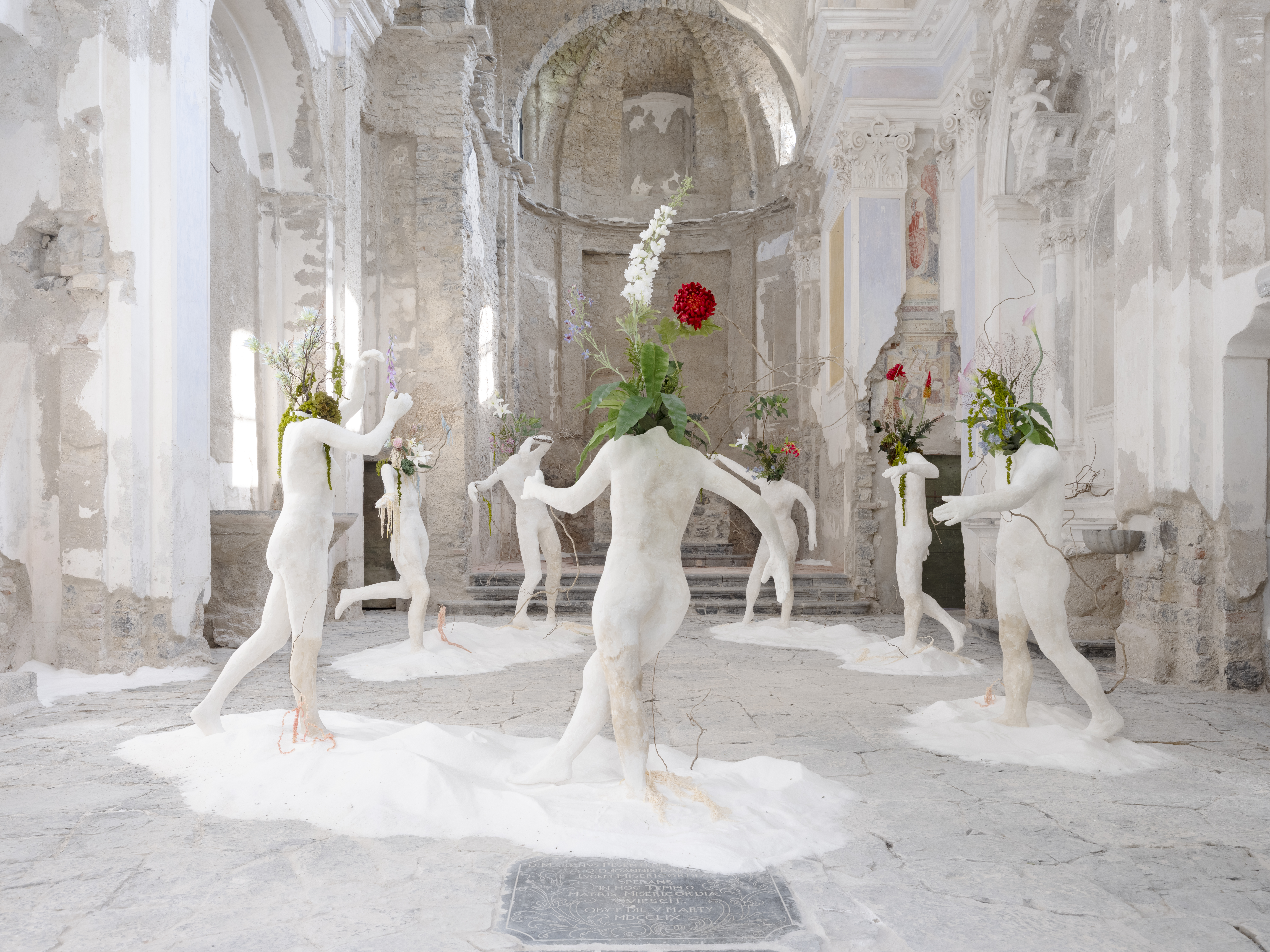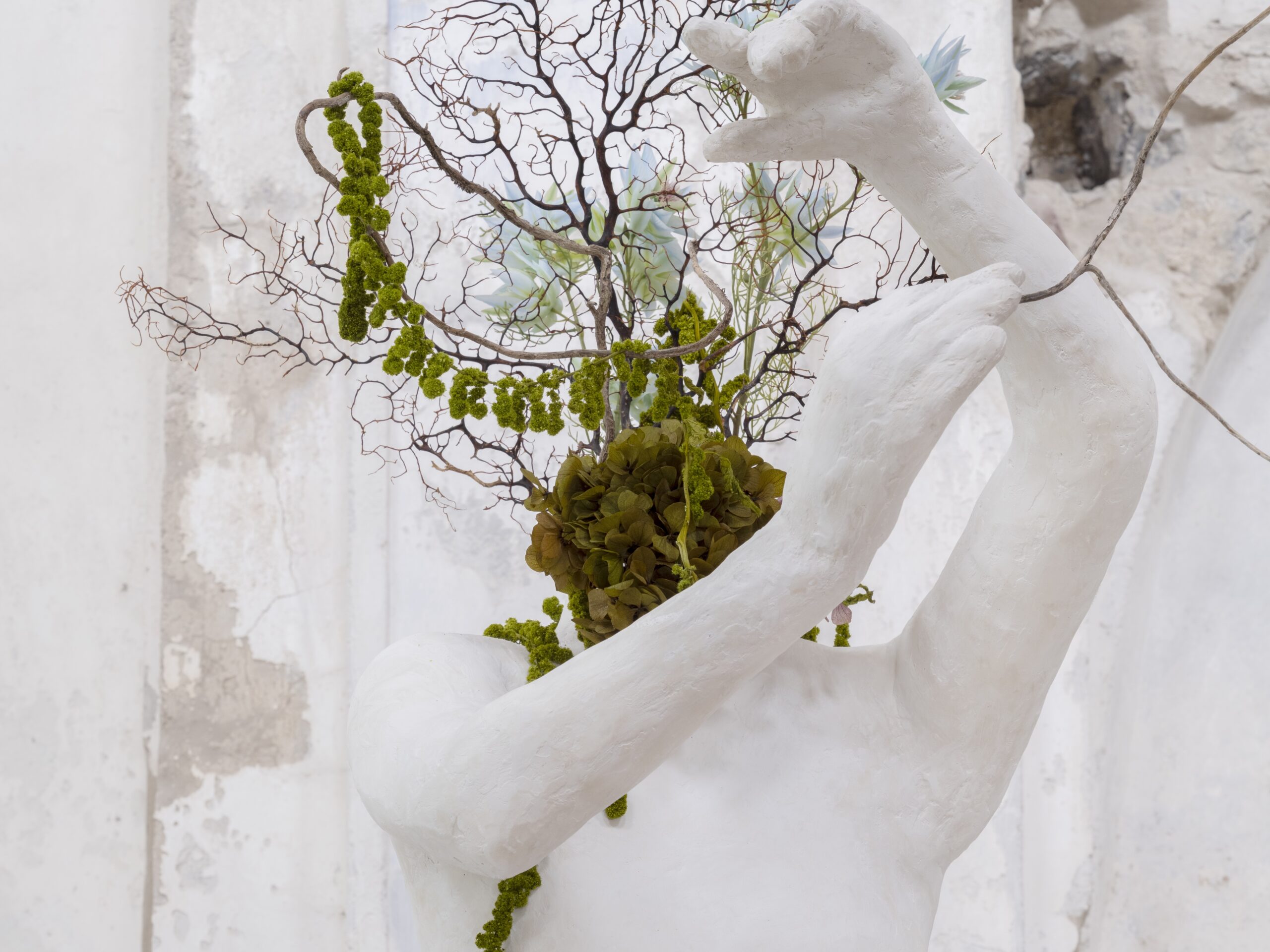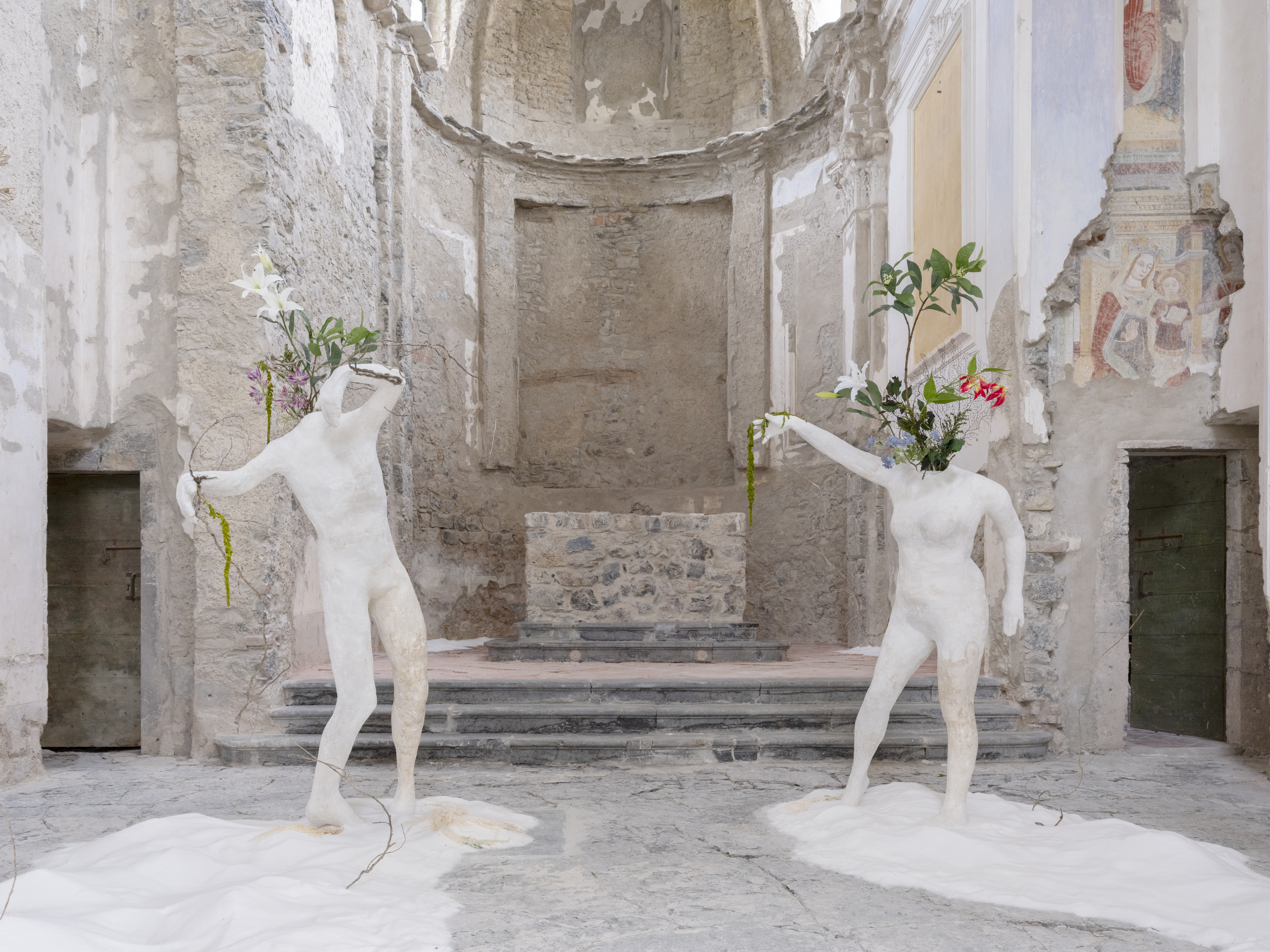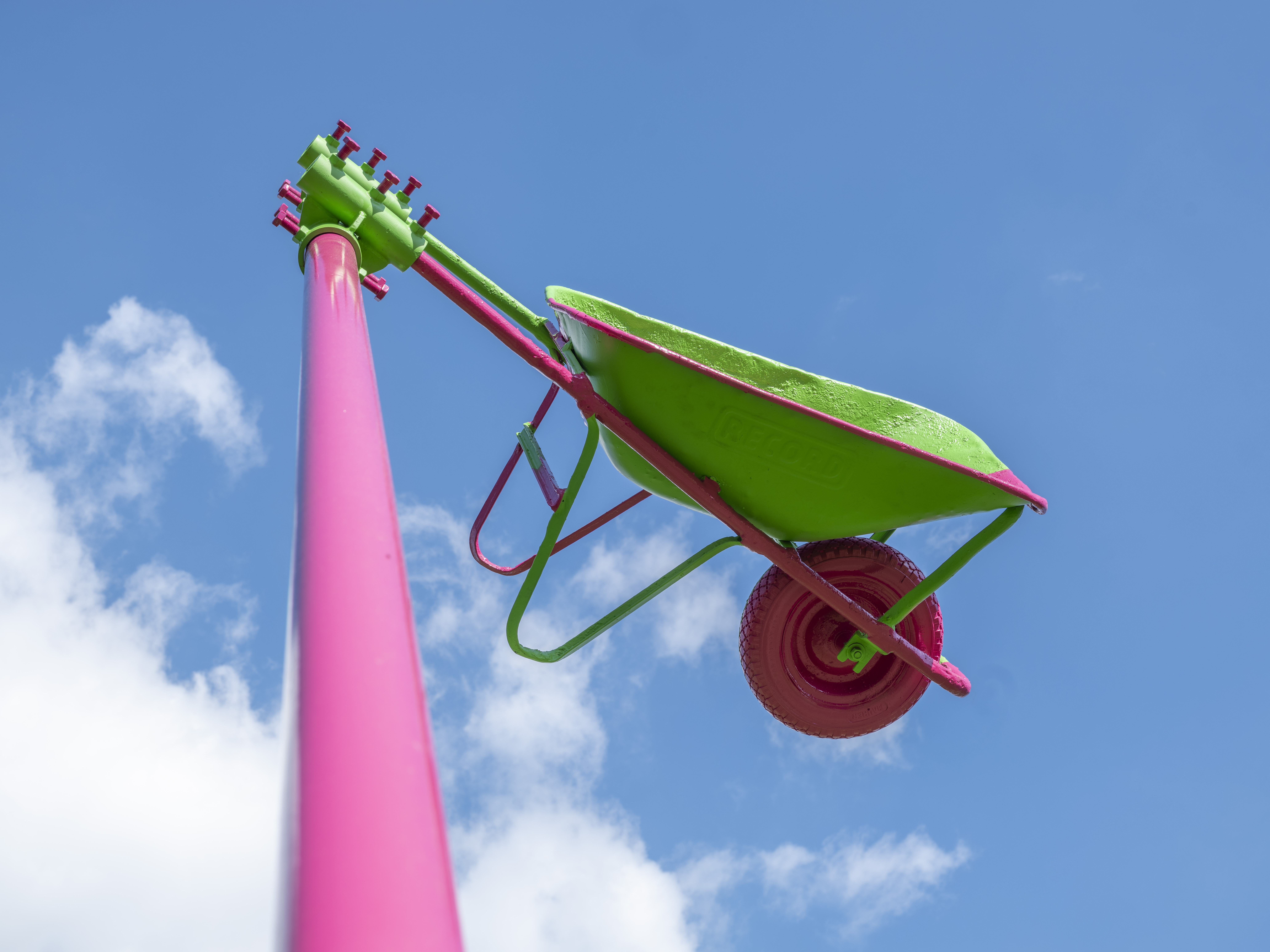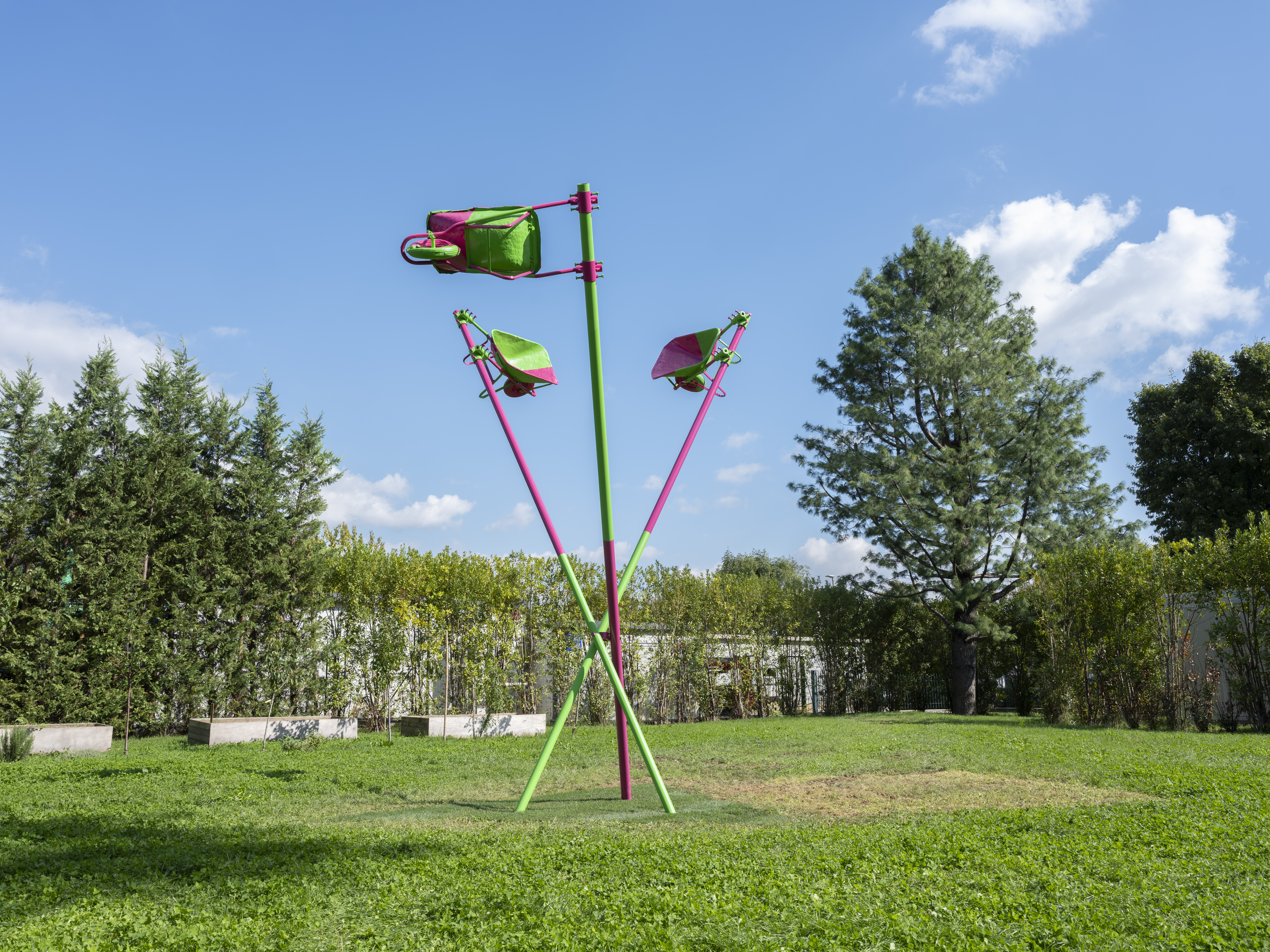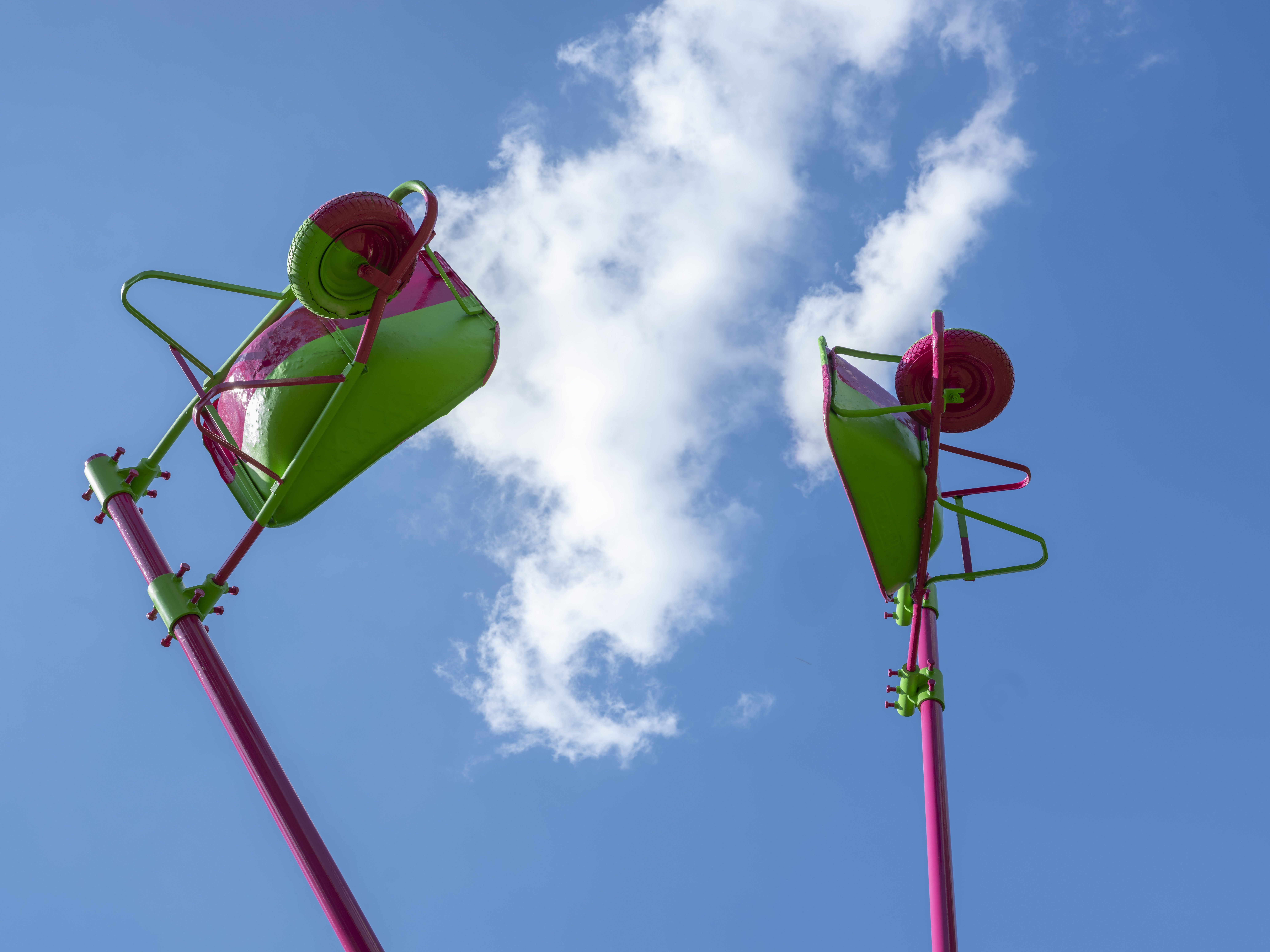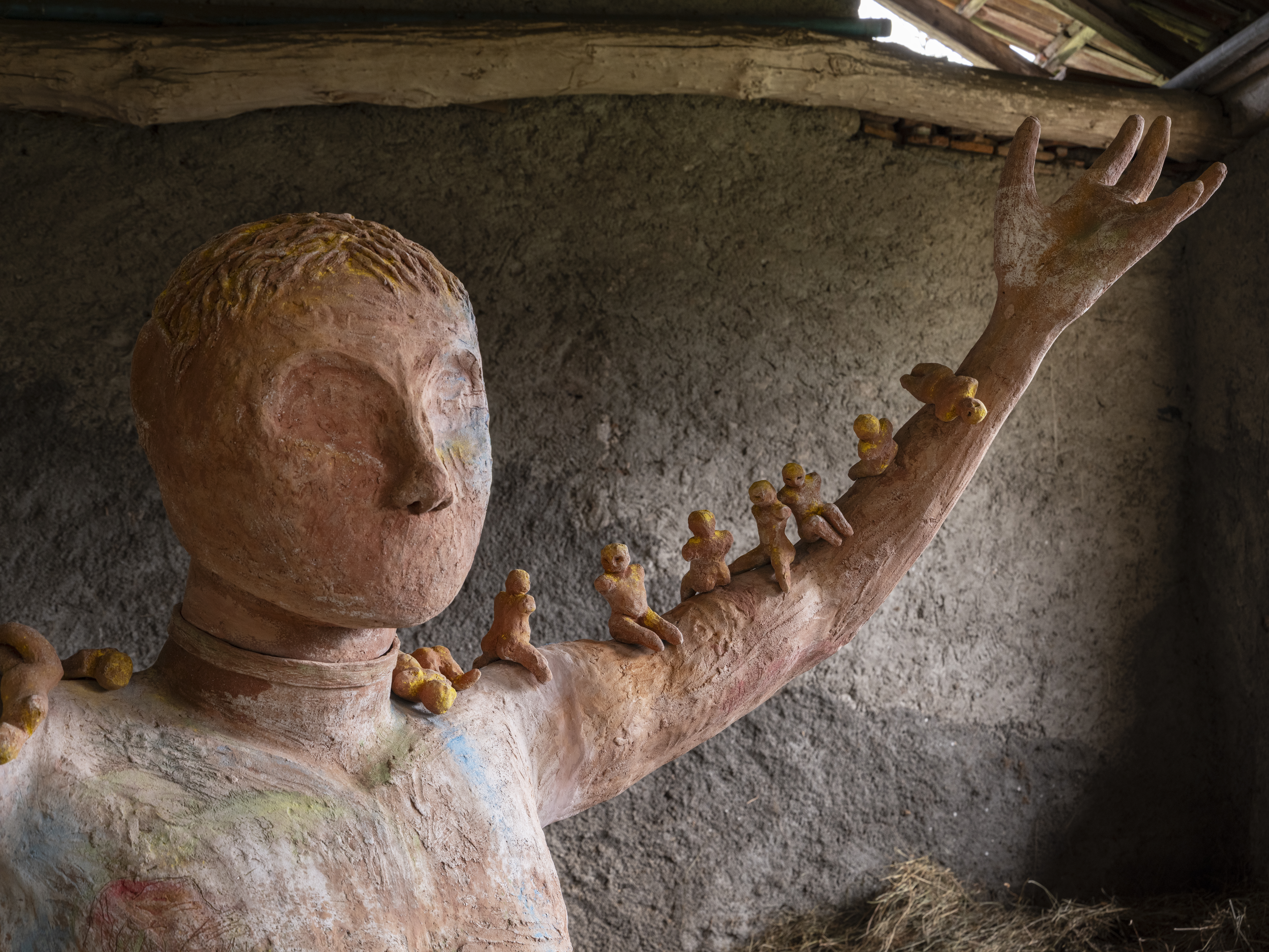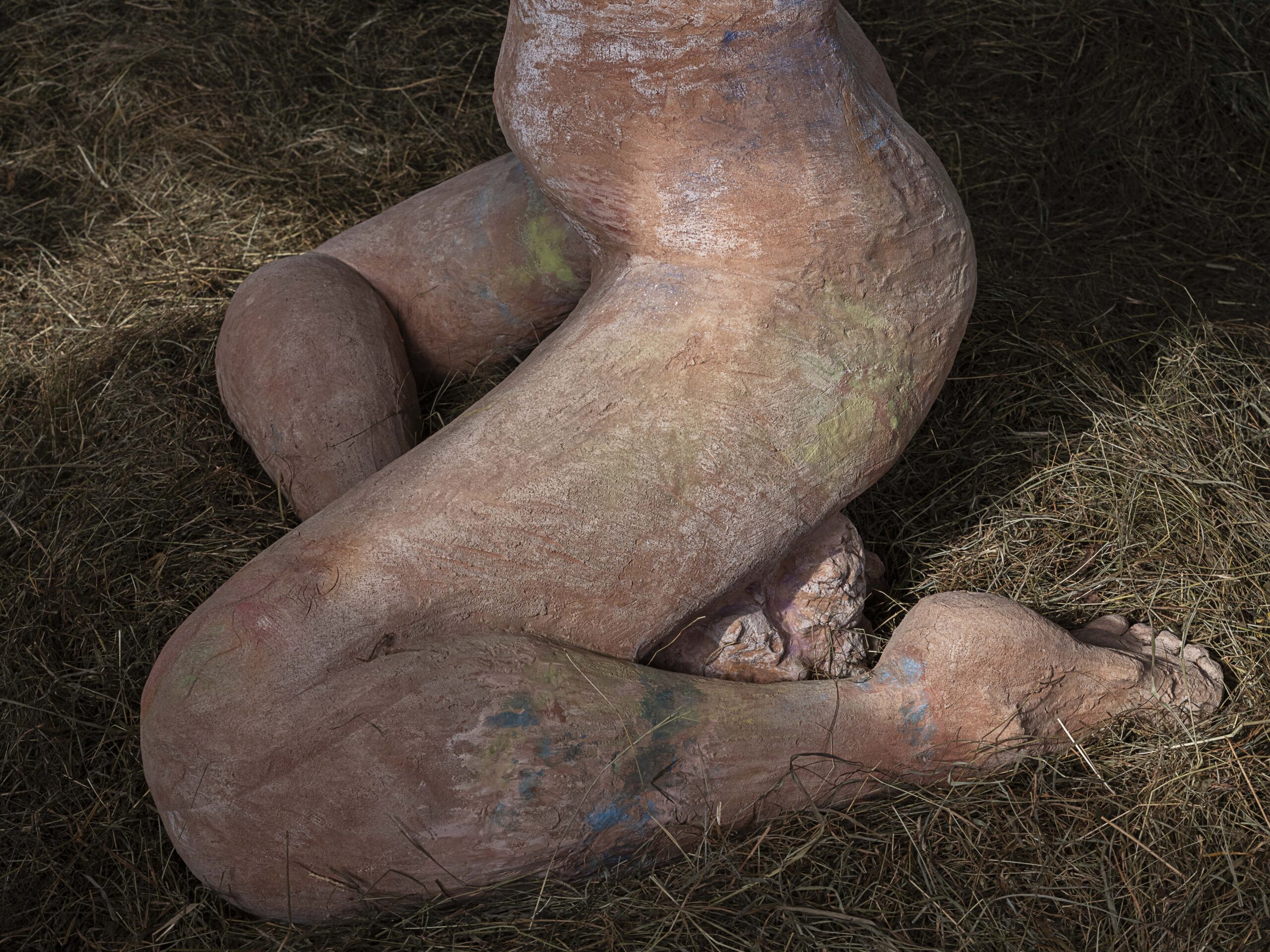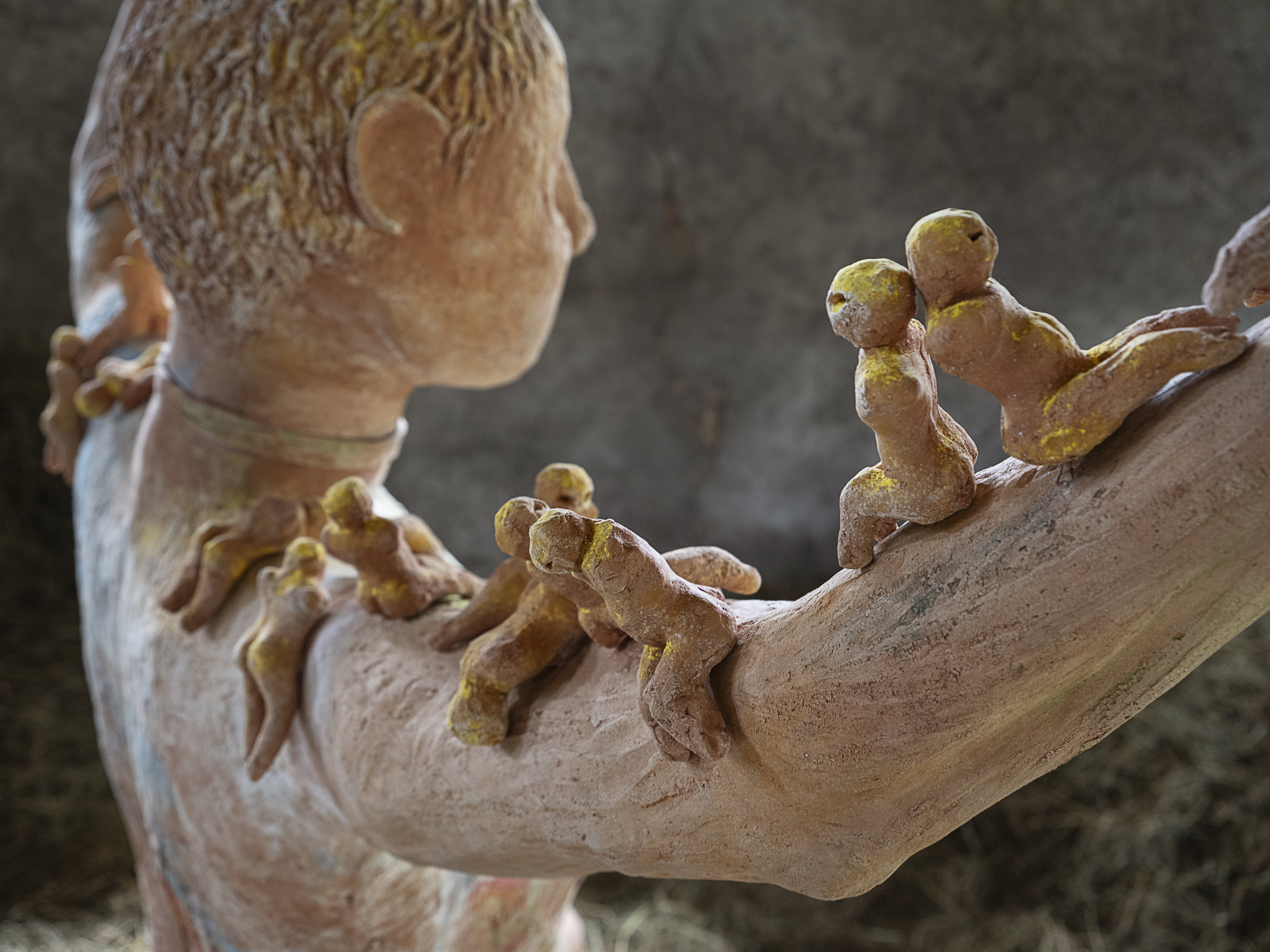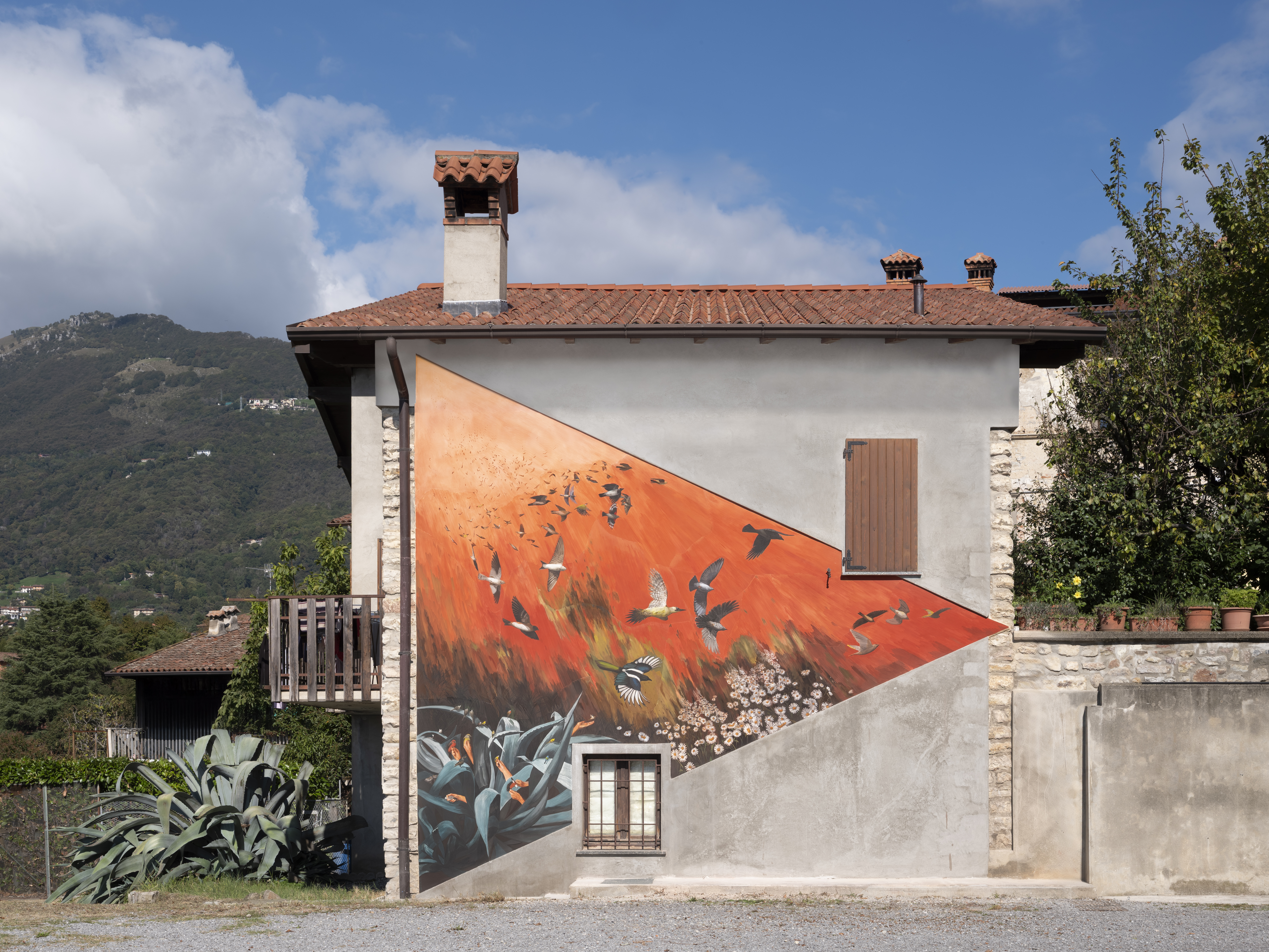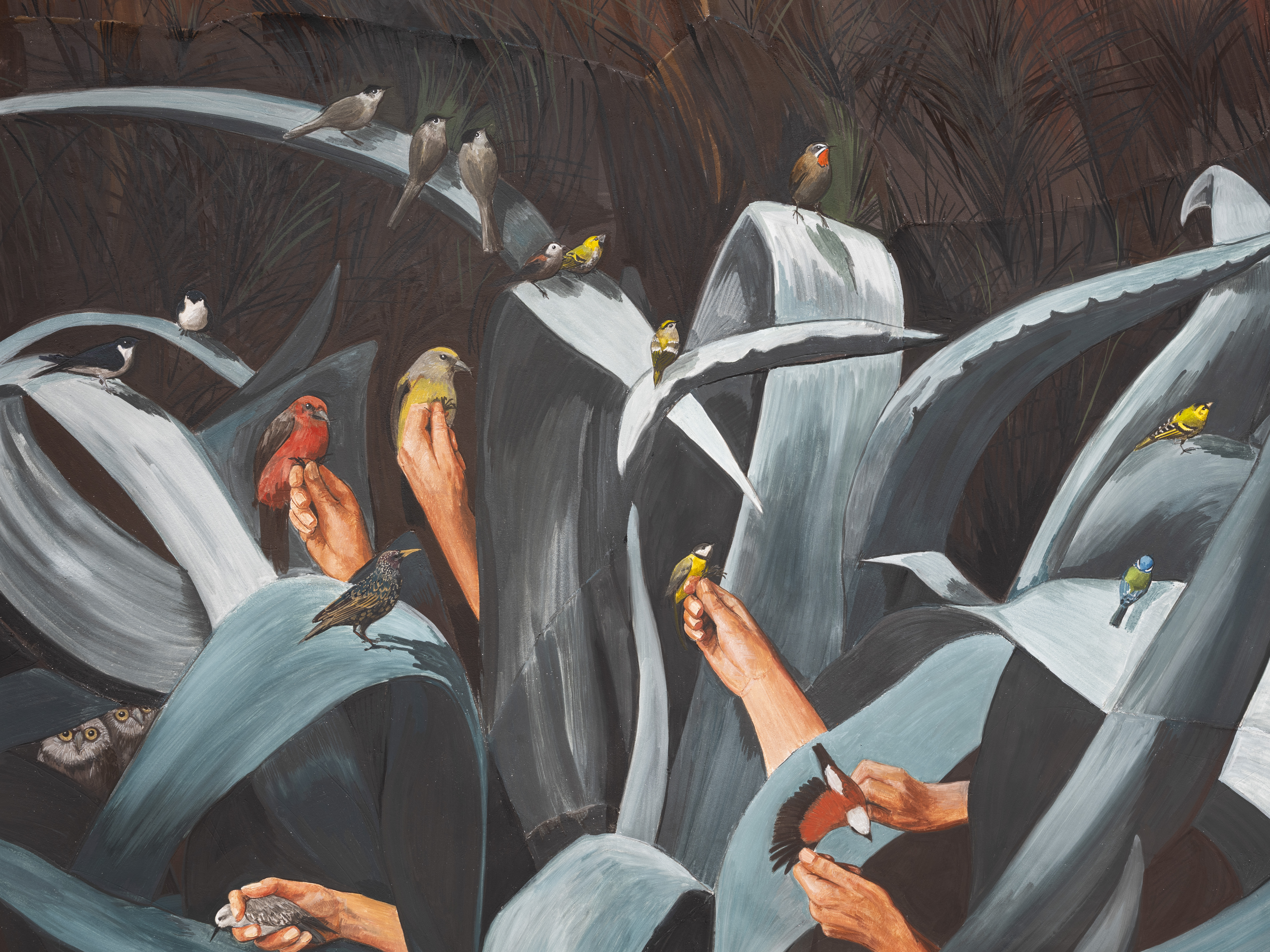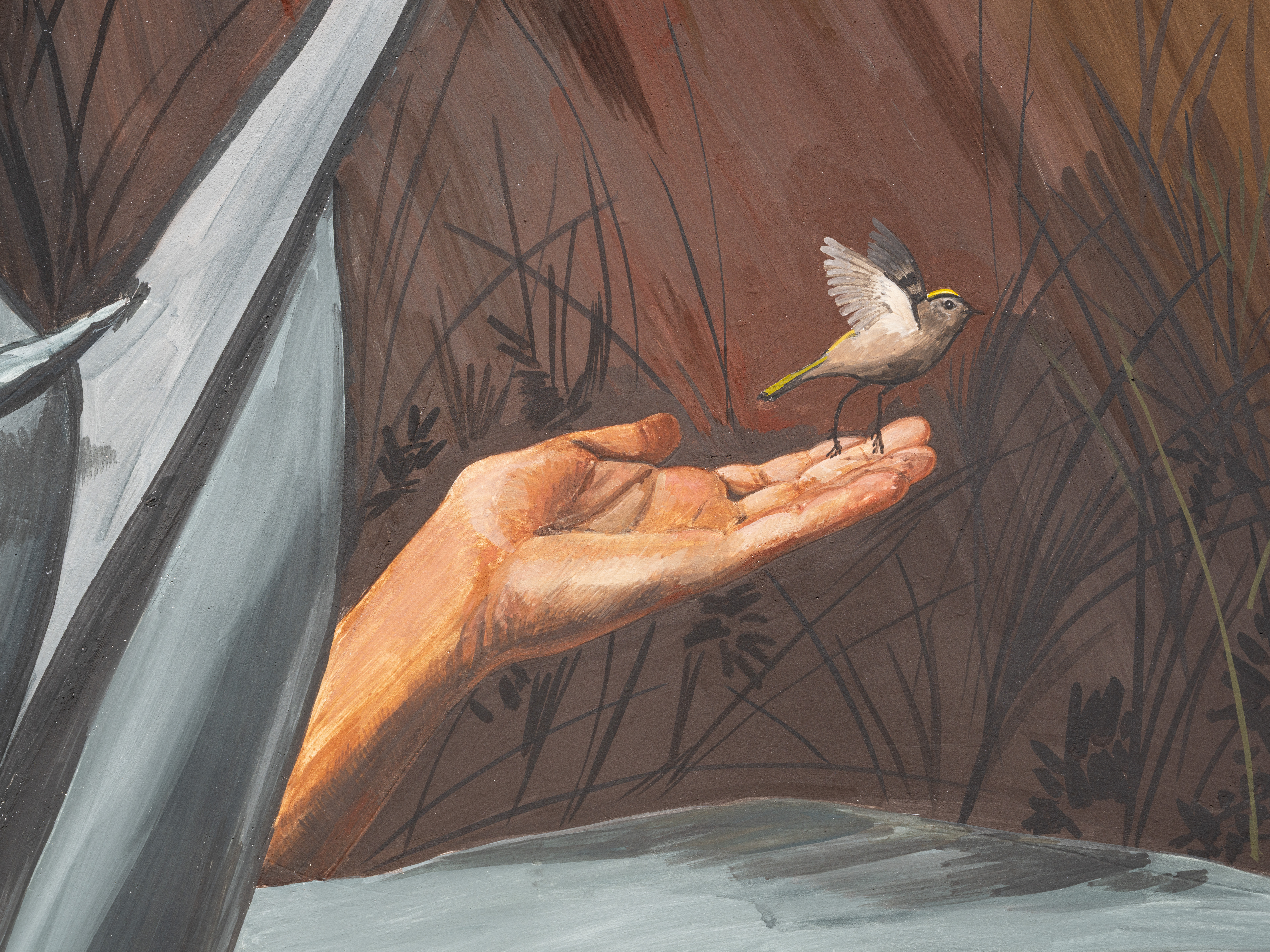The Orobie Biennial – Thinking Like a Mountain #5

The fifth cycle of Thinking Like a Mountain, the biennial program held by GAMeC – Galleria d’Arte Moderna e Contemporanea di Bergamo that engages local communities through the participation of international artists, will open on October 4, 2025 with the artistic direction of Lorenzo Giusti.
PEDRO VAZ
BECOMING MOUNTAIN
4 October 2025 – 18 January 2026
Bergamo, GAMeC
Becoming Mountain, a monumental pictorial installation by Pedro Vaz (Maputo, 1977), will also be presented. The work is inspired by the mountain landscape of the Alta Via delle Orobie Bergamasche and developed following a trekking experience through these mountains.
The painting depicts a view of the Presolana, conveyed through the gaze and direct encounter of the Portuguese artist: an approach that fully reflects his practice, grounded in direct contact with remote places. These are explored through expeditions that stimulate an immersive, bodily experience, from which Vaz’s creative process emerges, poised between figuration and abstraction.
The work enters into dialogue with Veduta del Pizzo della Presolana (1908) by Ermenegildo Agazzi, displayed at the entrance of the museum: a celebration of the massive Orobie peak, observed from a distant vantage point, which highlights the monumentality of its eastern wall. The perspective adopted by Agazzi reflects the nineteenth-century pictorial tradition of landscape painting, where nature was conceived as an object of aesthetic contemplation, viewed from afar and mediated by the human gaze.
More than a century later, Pedro Vaz approaches the same mountain with a radically different attitude. In August 2025, the artist undertook a three-day journey of nearly twenty kilometers, from Castione della Presolana to Colere, remaining side by side with the mineral wall — “so close that the horizon disappears.” The mountain becomes present, powerful, visceral; at its side, “the body ceases to be a spectator and becomes part of the mountain itself.”
In narrating the landscape as a lived and embodied experience, Vaz creates a large-scale painting executed on hanged paper. The view of the Presolana surrounds visitors through a concave curved structure, bringing them into close proximity with the painted surface, as though facing the dolomitic wall itself. In contrast with plein-air painting (and from a distance) typical of nineteenth-century painters, Vaz traces the contours of the alpine massif by relying on the memory of his walk. Through a process that eludes total control, he layers pigment on paper and then partially washes it away with water, generating unpredictable shadows and gradients.
The title of the Orobie Biennial, Thinking Like a Mountain, finds concrete expression in Vaz’s project, Becoming Mountain: an invitation to embrace the physicality of nature, to encounter it bodily rather than only visually — not to illustrate the mountain, but to live with intensity of being inside the mountain.
BIANCA BONDI
GRACES FOR GEROSA
4 October 2025 – 18 January 2026
Gerosa, Val Brembilla
Graces for Gerosa was conceived by artist Bianca Bondi (Johannesburg, 1986) specifically for the deconsecrated Romanesque church of Santa Maria in Montanis. Positioned in a strategic location, the church overlooks the landscape of Val Brembilla and the surrounding peaks, facing a network of ancient paths that once connected neighboring valleys. Although it no longer serves its religious function, Santa Maria in Montanis still preserves its evocative power.
Bondi’s project, developed in dialogue with the church’s austere stone architecture, returns to the community a space charged with meaning, heightening its suspended aura and symbolic vocation. At the center of the nave stands a sculptural ensemble of seven life-size figures, created in plaster from the bodies of local volunteers. Each sculpture is born of a direct cast: it is not the external surface that takes precedence, but the interior, which retains with precision the memory of physical presence. In this way, the hollow figures become true interior sculptures — shells that evoke human fossils, mineralized traces of gestures and movements. Like fossils, they preserve the imprint of an existence, offering permanence to those who lent their bodies for the making of the work.
In Graces for Gerosa, particular resonance is given to the reference to a female figure from iconographic tradition, read in art history as an emblem of the Nachleben der Antike (“afterlife of antiquity”): a dancing maiden, light and suspended between corporeality and spirituality. Those qualities of grace and lightness resurface here, embodied not in an abstract ideal but in the concrete physicality of seven volunteers from Gerosa — men and women of different ages. The iconography of the Graces, conceived as figures suggesting cosmic and collective harmony, finds new life in the community of the work, where the human body becomes a medium between the earthly and the immaterial, activating the continuity of gestures and forms through time. The movements, while echoing celebrated depictions of collective dance in art history — from Botticelli’s Three Graces in Primavera (1482), to the female figures in Mantegna’s Parnassus (1497), to the Etruscan ritual scenes of the Tomb of the Triclinium (5th century BCE) — are reimagined through the bodies of Gerosa’s inhabitants: unique bodies, with their own expressiveness, rewriting the original model.
The plaster of the sculptures seems to arise from the very fabric of the building that hosts them, as an ideal extension of Santa Maria in Montanis’s plastered walls. Natural light filtering through the church openings caresses the white surfaces, reflecting on the salt crystallizations scattered across the floor, and contributes to an atmosphere suspended between contemplation and release, spirituality and corporeality. The decision to strip the figures of their faces, replacing them with bouquets of flowers, corals, and crystallized organic matter, not only safeguards the identity of the participants but also transforms each body into a vital vessel of energy and rebirth.
In continuity with Bondi’s broader practice, Graces for Gerosa is rooted in her ongoing exploration of rituality and organic transformation. In her work, Bondi combines installation, sculpture, and performance with materials in constant flux — dried flowers, water, crystals, pigments, salt — creating environments that behave as autonomous ecosystems, evolving over time. Her site-specific installations often activate collective rituals and spaces for sensory meditation, opening up the possibility of conceiving different exhibition sites as living organisms, permeable to change and to natural forces. Moving along the threshold between life and decay, Bondi creates environments that assume the form of shared ceremonies. Each natural element becomes an instrument of metamorphosis and rebirth.
Historically, dance was forbidden in sacred spaces, deemed an irreverent act. With Graces for Gerosa, this taboo is overcome: movement returns to the church not as rebellion but as reconciliation, a ritual that restores to the human body its role as a bridge between the earthly and the immaterial. Dance thus becomes a universal language of union and collective celebration.
ABRAHAM CRUZVILLEGAS
AN UNSTABLE AND PRECARIOUS SELF-PORTRAIT MUNCHING SOME TRADITIONAL FRITOS, SIPPING A COUPLE OF CABALLITOS OF CASA DRAGONES, AFTER A BUSY JOURNEY WITH SOME DEAR FRIENDS, LISTENING AT THE SAME TIME TO THE ‘CLAIR DE LUNE’, PERFORMED BY MENAHEM PRESSLER, AND ‘FOLIE À DEUX’, BY STEFANI JOANNE ANGELINA GERMANOTTA
4 October 2025 – 18 January 2026
Dalmine
The artist Abraham Cruzvillegas (Mexico City, 1968) presents a new site-specific intervention in the heart of the industrial area of Dalmine: a work conceived as a collective and relational gesture, created in collaboration with Fondazione Dalmine, the Municipality, and three local social cooperatives (Il Sogno, La Solidarietà, and Oasi Il Picchio Verde). The piece was realized using discarded materials and everyday objects sourced from the industrial context of TenarisDalmine and from the surrounding agricultural realities.
Installed in the park of Fondazione Dalmine, the sculpture is the culmination of a process that places value on participation, improvisation, the unforeseen, error, and instability as guiding tools for Cruzvillegas’s reflection. In continuity with his well-known practice of autoconstrucción — an approach inspired by the spontaneous, informal housing processes in the outskirts of Mexico City where he grew up — the artist has adapted his methodology to the specificity of this context. For its composition, he selected elements imbued with the cultural and territorial stratifications of the area, with references to Dalmine’s economic history, its natural landscapes, its flora and fauna, engineering, labor, and solidarity.
The ultra-matte green and hyper-glossy pink chosen to paint the three wheelbarrows perched atop steel tubes, like improvised flags, are colors that have recurred in Cruzvillegas’s work since 2004, when the artist visited the Mangueira samba school, located in the favela of the same name in Rio de Janeiro — a place deeply linked to Hélio Oiticica, who used to dance there and conceived his celebrated Parangolé. On that occasion — which Cruzvillegas describes as a true artistic pilgrimage — the adoption of this chromatic combination was born, as a tribute to the Mangueira community and Oiticica’s legacy.
By applying the two colors in a mirrored image — each covering half of the surface — the artist creates a horizontal contrast that bisects the sculpture’s elements, as though traversed by a visual “horizon line.”
As is often the case in Cruzvillegas’s practice, the work refuses a univocal meaning or didactic reading. Instead, it positions itself as an open device, capable of evoking different images depending on the gaze of the viewer. The wheelbarrows may be read as tools of agricultural labor or symbols of industrial toil; the steel poles may suggest industrial infrastructures or ritual totems. In any case, the work invites us to rethink our interpretive categories, to look at the territory with renewed eyes, to renegotiate the ambiguous and shifting notions of what we call “progress,” and to reflect on our relationship with both environment and history.
The title, An unstable and precarious self-portrait munching some traditional Fritos, sipping a couple of caballitos of Casa Dragones, after a busy journey with some dear friends, listening at the same time to the “Clair de lune,” performed by Menahem Pressler, and “Folie à Deux,” by Stefani Joanne Angelina Germanotta, does not define the work but, like the assemblage of seemingly dissonant elements that configure the sculpture, alludes to the mixture of individual and collective experiences, personal memories and global cultural references, coexisting without hierarchy in an open and polysemic composition.
On the opening day, musician and performer Dudù Kouate will activate the sculpture through sound, together with several wheelbarrows used in the daily work of the Cooperatives involved in the project. The performance — born of a dialogue between Kouate and Cruzvillegas — narrates the creative process and the sculpture through sound and music.
GAIA FUGAZZA
MOTHER OF MILLIONS
4 October 2025 – 18 January 2026
Sottochiesa, Val Taleggio
The project developed by Gaia Fugazza (Milano, 1985) in collaboration with NAHR – Nature, Art & Habitat Residency, following a residency in Val Taleggio, takes the form of a large-scale sculpture made of Impruneta clay. Hand-built using the coil technique and deliberately left unsmoothed, the material’s porosity allows salts to emerge on the surface, forming a whitish, cheese-like patina that gives the work a living quality, in constant transformation.
The sculpture represents a human figure inspired by the plant Mother of Millions (Kalanchoe delagoensis), a succulent native to Madagascar capable of reproducing asexually by generating clones along the edges of its leaves: new shoots that, when they fall to the ground, produce other plants. For Fugazza, this regenerative ability becomes a metaphor where the vegetal and the human mirror each other in a shared tension toward continuity and transformation.
The figure is modeled with outstretched arms in a gesture that seems at once to support the effort of rising and to offer an embrace to the community, evoking mutual support. The arms, laden with bud-like offspring, appear both ready to welcome a further multitude and at the same time seeking strength in order to rise and carry on. The absence of defined facial features removes any sense of individual identity, transforming the sculpture into a collective body, one that sustains the community and to which it, in turn, belongs. Mother of Millions raises implicit questions: Who takes care? Who receives care? To whom is the obligation of care assigned? To reflect on these questions means recognizing the generative power of care itself, its capacity to foster collective thinking and to bring forth critical knowledge and practices.
The surface of the work is etched and pigmented with depictions of plants, flowers, grazing animals, shepherd dogs, and the meadows of transhumance—visual fragments gathered by Fugazza during her stay in Val Taleggio. These signs, impressed into the terracotta, evoke an archaic language, recalling the memory of rock engravings as some of the earliest gestures through which human communities inscribed their presence in the world. Where once elongated humanoids, therianthropic figures, and other marks told of ritual practices, divinations, or altered states of consciousness, here they become the very skin of the body-sculpture, incorporating and restituting the surrounding landscape. They connect the human to the more-than-human, the corporeal to the cosmic. There is no separation between body and environment: the body is landscape, and the landscape is body. This osmosis affirms an invitation to rethink the human not as “other” than nature, but as an inseparable part of an extended ecosystem.
Installed in the Stalla Gherba of Sottochiesa, a rural building in Val Taleggio rich with character, the work establishes a profound dialogue with a space that traditionally shelters animals and daily labor, while opening onto the valley beyond. This place of sustenance becomes here the custodian of a sculpture that interrogates the relationship between care, regeneration, and community.
Fugazza’s practice has long been characterized by the creation of human figures that, while retaining anthropomorphic traits, freely transform into other beings and species, eluding rigid identity definitions. These are bodies in constant metamorphosis, crossing biological, sexual, and cultural boundaries, embodying a form of nomadism that goes beyond the formal dimension to assume political and ecological meaning. Her works propose a body that does not root itself, but rather hybridizes and reinvents, reflecting the condition of mountain communities: often perceived as isolated, yet finding their strength precisely in adaptability and mutual support.
The sculpture thus becomes the symbol of a universal body—fragile and powerful at once—inviting us to imagine the human as part of an ecosystem in continual transformation. A body that, like the plant from which it draws inspiration, generates and regenerates, multiplies, and offers itself to the multitude.
After its presentation in Val Taleggio, Mother of Millions will be exhibited at GAMeC.
AGNESE GALIOTTO
LA MONTAGNA NON ESISTE (MOUNTAIN DOES NOT EXIST)
From October 4, 2025
Almenno San Bartolomeo
The artist Agnese Galiotto (Chiampo, 1996) transforms a wall in the historic center of Almenno San Bartolomeo into a visual narrative full of suggestion, exploring the deep relationship between human beings and nature.
The fresco, created using traditional techniques, unfolds on a wall overlooking the town’s central square. Its triangular composition echoes the silhouette of Monte Albenza in the background, which seems to continue seamlessly into the painting itself. This shape becomes the foundation for a visual narrative in which a flock of birds—composed of dozens of different species—moves from the peaks down toward the plain, while others observe from below, hidden among the thick leaves of an agave plant. At the heart of the plant, hands emerge, forming gestures that suggest, on one hand, the precise scientific practice of bird ringing, and on the other, the intimate and everyday act of picking a flower. In this interplay of images, conjoined daisies—double flowers on a single stem—become a metaphor for the artist’s research: images of union and ambivalence, speaking of fragility and resilience, but also of seemingly irreconcilable forms of coexistence.
The dominant color, a warm and deep brick tone, recalls not only the ancient plasterwork of the village and the autumn woods, but also the artist’s personal memories of night journeys across Europe during her years of study, where artificial lights seemed to slice through mountains like tongues of fire. This vision is translated into the fresco through poetic, suspended images, where boundaries dissolve. And yet, while borders and crossing zones may be points of interruption or arrest for humans, they become continuous corridors for migratory birds—linking different geographies and dissolving the very notion of national borders, offering instead the image of a unified, ever-moving landscape.
In a land historically tied to hunting, The Mountain Does Not Exist offers a new, non-romanticized way of relating to the animal world. Migratory birds become symbols of a fragile but constantly moving ecosystem, of a landscape that unites rather than divides, opening itself to new possibilities for listening, care, and coexistence.
ASUNCIÓN MOLINOS GORDO
CROPS ARE NOT ORPHANS
October 2025 – January 2026
Astino (Bergamo)
In the Biodiversity Valley of Astino, in collaboration with the “Lorenzo Rota” Botanical Garden of Bergamo, Spanish artist Asunción Molinos Gordo (Aranda de Duero, 1979) will lead the participatory art workshop Crops Are Not Orphans. Starting from the seed archive held by the Botanical Garden, the project will collect and share the stories connected to the seeds, proposing a collective reflection on the concept of Seeds Kinship—the ability of seeds to create emotional bonds and nourish a sense of belonging.
The title refers to the term Orphan Crops, used by the scientific community to describe seeds considered insignificant for research or lacking ownership—standing in contrast to the idea of Seeds Kinship. For Molinos Gordo, however, seeds are deeply entwined with people’s life stories and carry emotional and relational value.
The workshop will involve ten participants from community gardens across the province of Bergamo. It will unfold over three working days in October and three more in January. At the end of the process, the artist will create a visual piece reflecting the collective work, to be exhibited in the museum’s spaces.
Date
October 11, 2025
